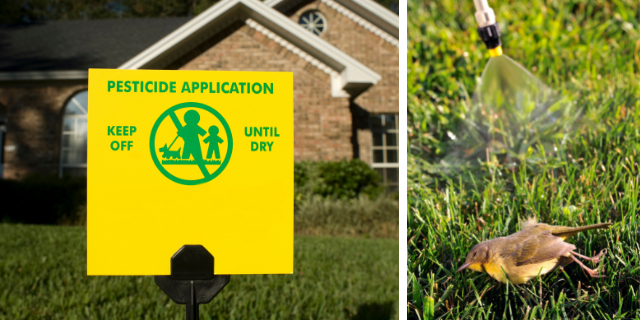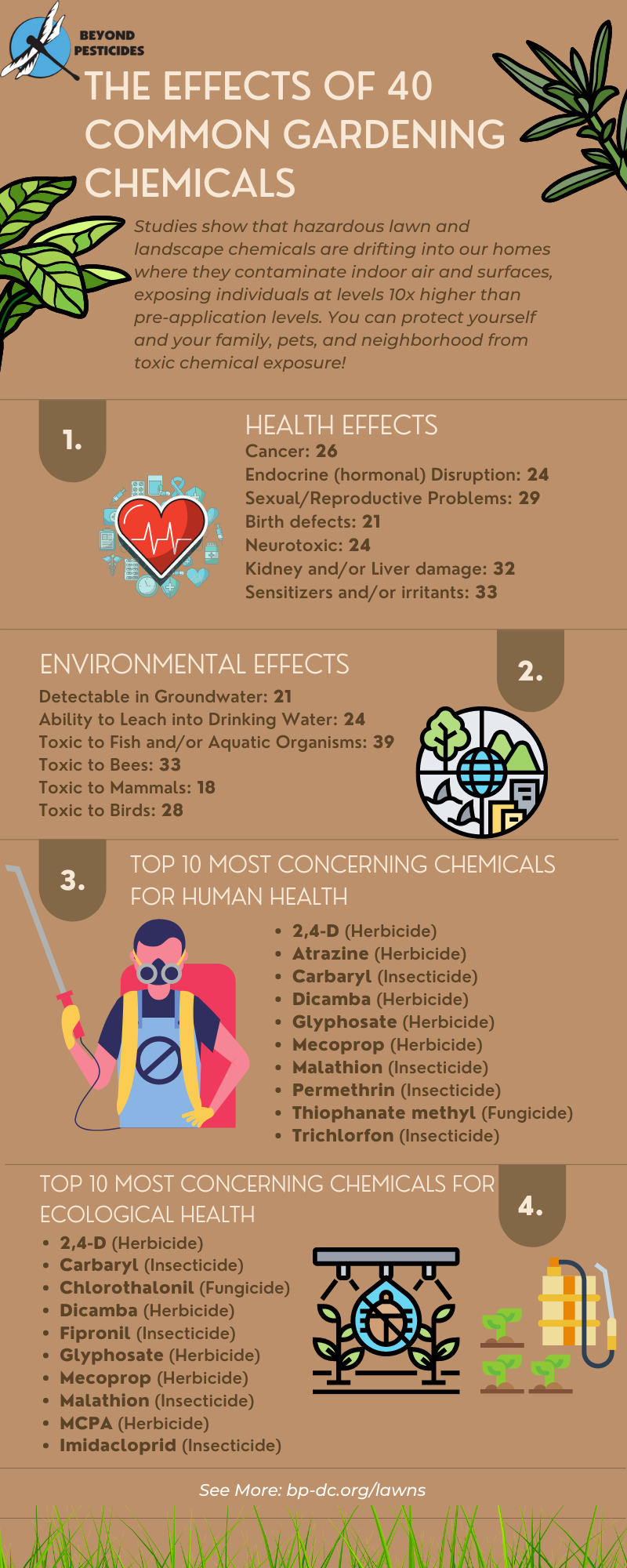14
Oct
New Factsheets Alert Communities to Adverse Effects of Commonly Used Landscape Pesticides

Health and environmental effects disclosed on factsheets to guide community decisions on lawn and landscape management that do not poison people and contaminate the environment.
WASHINGTON, D.C. (October 14, 2021) — Today, the national environmental and public health group Beyond Pesticides is releasing its health and environmental effects factsheets for “40 Commonly Used Lawn Pesticides,” updating and expanding on previous factsheets on 30 pesticides. These comprehensive factsheets documents with scientific citations a wide range of diseases and ecological effects linked to pesticides. The underlying analysis supporting the adverse health and environmental effects identified in the factsheets are based on toxicity determinations in government reviews and university studies and databases.
What do the factsheets disclose? Of the 40 most commonly used lawn and landscape pesticides, in reference to adverse health effects, 26 are possible and/or known carcinogens, 24 have the potential to disrupt the endocrine (hormonal) system, 29 are linked to reproductive effects and sexual dysfunction, 21 have been linked to birth defects, 24 are neurotoxic, 32 can cause kidney or liver damage, and 33 are sensitizers and/or irritants. Regarding adverse environmental effects, 21 are detected in groundwater, 24 have the ability to leach into drinking water sources, 39 are toxic to fish and other aquatic organisms vital to our ecosystem, 33 are toxic to bees, 18 are toxic to mammals, and 28 are toxic to birds.
In addition to the factsheets, Beyond Pesticides manages the Gateway on Pesticide Hazards and Safe Pest Management (Pesticide Gateway) and Pesticide-Induced Diseases Database to track the scientific literature and the federal and state regulatory process governing pesticides. Additionally, the organization manages a database, ManageSafe, to address nontoxic methods for common pest management issues.
The 40 commonly used factsheets are a tool for local land management decision-making. Empty cells in the factsheet chart may refer to either insufficient data or if currently available data considers the chemical relatively non-toxic. The ledger following the common chemicals chart includes information on how to interpret the categorization of specific compounds. For instance, the ¥ symbol next to atrazine indicates that this chemical has residential uses specific to the Southeast United States. However, atrazine is also heavily used on Midwestern farms and readily contaminates midwestern waterways, leading to nationwide contamination, information that will be found on the Pesticide Gateway.
“People and community decision-makers need an easy-to-use tool to make informed choices on protecting health and the environment,” said Akayla Bracey, Beyond Pesticides’ science and regulatory manager. “Using this tool in combination with additional tools for sustainable management practices is critical to community and ecological health,” Ms. Bracey continued.
The factsheets distill a large amount of scientific data. For example, the main chemical ingredient in Roundup® — glyphosate — is the world’s most widely used herbicide. The factsheet identifies glyphosate as a probable human carcinogen, based on findings from the World Health Organization’s (W.H.O.) International Agency for Research on Cancer (IARC). Additionally, research has linked glyphosate to high rates of kidney disease in farming communities and to shortened pregnancy in a cohort of women in the Midwest. Animal studies and bioassays link it to endocrine disruption, DNA damage, decreased sperm function, disruption of the gut microbiome, and fatty liver disease. Glyphosate is also linked to environmental damage. The EPA warns that glyphosate can injure or kill 93% of U.S. endangered species. It is a primary driver of the decimation of monarch butterfly populations because it destroys the milkweed plants their young depend on. Recent research has also shown that glyphosate can disrupt honey bee gut microbiomes, affect larval development, increase colony vulnerability to pathogen infestation, reduce productivity, and impair honeybee navigation, linking the herbicide to declines in bee populations.
View the new factsheets for both Health and Environmental Effects of 40 commonly used lawn and landscape pesticides: Health Effects of 40 Lawn Pesticides 2021.pdf (beyondpesticides.org); Environmental Effects 40 Lawn Pesticides 2021.pdf (beyondpesticides.org)
About Beyond Pesticides
Beyond Pesticides is a 501(c)3 nonprofit organization headquartered in Washington, D.C., which works with allies in protecting health and the environment with science, policy, and action to lead the transition to a world free of toxic pesticides.











